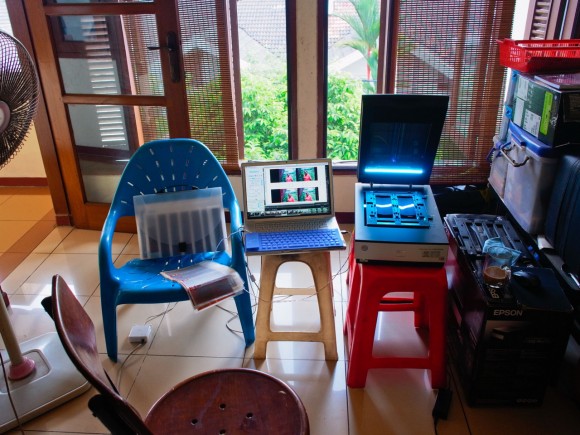
Scanning negatives marathon. © Andri Tambunan
Indonesian photographer Andri Tambunan has finally completed his long term project Against All Odds, a documentary report on the AIDS epidermic in Papua. The project recieved the inaugural Reminders Project Asian Photographers Grant and will be exhibited at the Angkor Photo Festival in December. In this series of articles, we invite Andri to share with us his experience and process pursuing his first long term project.
How did you prepare yourself – moving from the comfort of your known & familiar surroundings to a foreign environment with unfamiliar people to pursue your project?
Although I grew up in the States, I started backpacking to SE Asia and S. America on my own since age 17. As a result, I had some experience transitioning to foreign surroundings and giving up certain luxuries such as A/C, TV, hot water, mattress, daily shower, etc. Years of traveling had made me street savvy and accustomed in exploring uncharted places. However, before departing to Papua I took some provisions including researching Papua’s history, culture, customs, and dialects, keeping up with the latest news, and being aware of potential dangers and places to avoid. Also a month before departing to Papua I had also started eating meat to transition from my vegetarian diet. All of these things helped me to adapt and assimilate to my new surroundings.
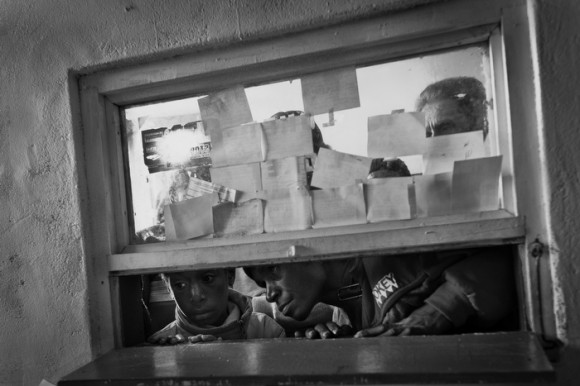
Against All Odds. © Andri Tambunan
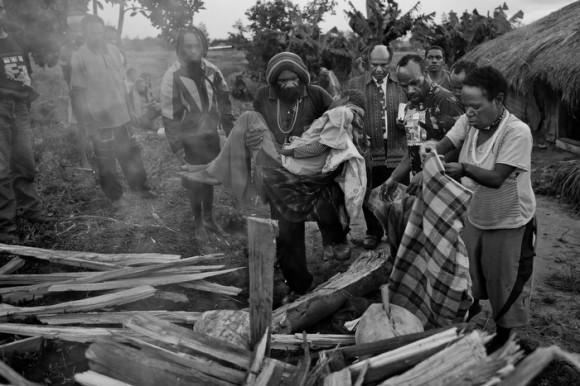
Against All Odds. © Andri Tambunan
Good rules of thumb for me are to anticipate some worst-case scenarios and have several exit strategies. Some of my precautions/preparation include acquiring accidental insurance and making copies of my passport, ID, and bankcards and leave them with someone I trust back home. I also scan them and store the files in a rugged encryptable flash drive and send them to my email so I can access it anywhere online. In addition, I bring First AID kit and medicines for common sickness i.e. cold, diarrhea, headache, etc. I also get vaccinations as necessary, learn self defense, wear clothing that helps me blend in and bring comfortable shoes, a small tool set, a pocketknife, a compass, notebook/journal, music, movies, and anything that helps me keep my sanity.
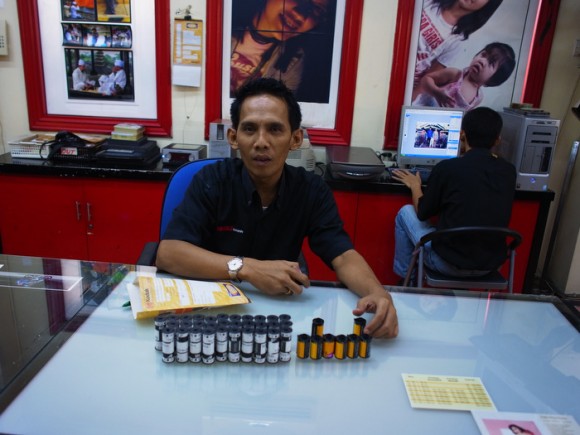
Dropping off 41 rolls of film to be developed at Emerald Kemang, Jakarta. © Andri Tambunan
How did you balance budget and project needs?
I had already anticipated expenditures to complete this project. My expenses include, flights (domestic & international), visa, lodging, food, local transport, fixer and miscellaneous expenses, films & processing, consultation, multimedia production, books and promotional items. Adding up these foreseeable expenses in each category gave me a rough total estimate. It is important to not exceed the estimated amount of each category. But for me, the key was to stay well below so I could allocate the money to cover other or unexpected expenses. For example, I saved a lot of money by renting out a small room rather than staying in a hotel. I had to sacrifice the comfort of having a private bathroom, A/C, TV, house cleaning, etc.
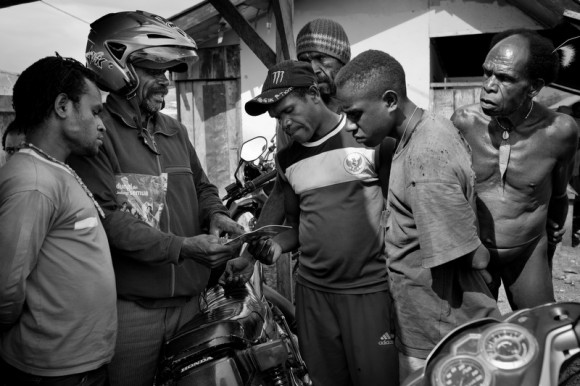
Against All Odds. © Andri Tambunan
Also, I took public transportations and only hired a driver/car only when I absolutely need them. However, the money that I saved from lodging and transportation was transferred to cover the rising costs of flights within Papua. Running out of money in the middle of the project and especially while still on the field could be a significant setback and put your project in jeopardy. It could be a waste of time and effort to return in the middle of shooting because the money runs out. Or worst you might end up with a half-assed completed project. Thus, balancing a budget to project needs requires pre-visualization, planning, and making appropriate sacrifices (don’t compromise on your safety and quality service).
Did you make mistakes along the way? What did you do to overcome them?
I made many mistakes along the way that I didn’t regret because I learned from those faults. How did I overcome them? I corrected those errors, looked for alternate solutions, and tried again. “Take chances, make mistakes. That’s how you grow. Pain nourishes your courage. You have to fail in order to practice being brave.” Also, sometimes to correct or prevent a mistake we need to simply ask for help.
Check out Andri’s ‘Against All Odds’ Tumblr blog for more: http://againstalloddsinpapua.tumblr.com/
Read Part Four: Pt 4: A Matter of Balance & Management
Read Part Two: Pt 2: Connecting with Subjects and Equipment Checklist
Read Part One: Pt 1: Andri Tambunan, Against All Odds
Share

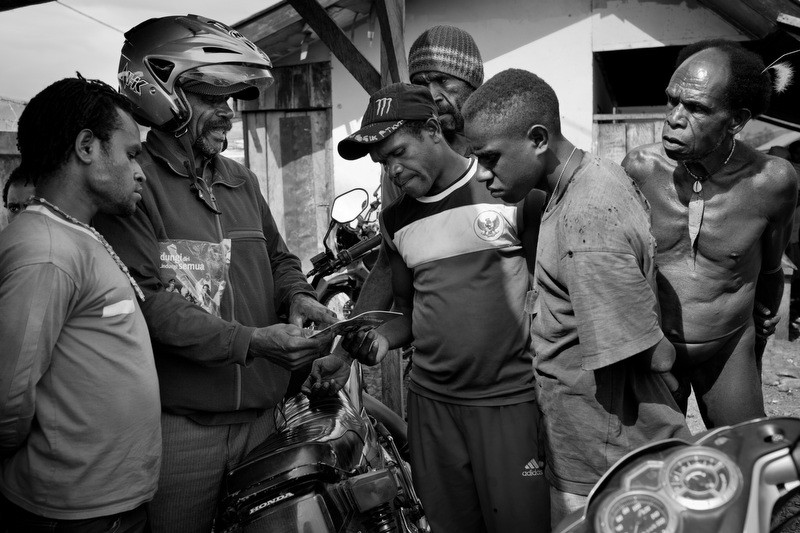
Comments 10
Working on Long Photo Term Projects Pt 3: Budgeting & Anticipating Worst-case Scenarios, #ipaphotoasia http://t.co/El9zOfUL
Working on Long Photo Term Projects Pt 3: Budgeting & Anticipating … http://t.co/cTZ0oUOB
Working on Long Term Projects Pt 3: Budgeting & Anticipating Worst-case Scenarios http://t.co/JB3NLi3z #photojournalism
Working on Long Term Projects Pt 3: Budgeting & Anticipating Worst-case Scenarios http://t.co/JB3NLi3z #photojournalism
Working on Long Term Projects Pt 3: Budgeting & Anticipating Worst-case Scenarios http://t.co/R1ZP4tfG #photography #alltop
RT @InvisPhotogAsia: Latest Post: Working on Long Term Projects Pt 3: Budgeting & Anticipating Worst-case Scenarios. http://t.co/tXHb0iHC
Working on Long Term Projects Pt 3: Budgeting & Anticipating Worst-case Scenarios http://t.co/JB3NLi3z #photojournalism
Working on Long Term Projects Pt 3: Budgeting & Anticipating Worst-case Scenarios http://t.co/SW8DgXup
Latest Post: Working on Long Term Photo Projects Pt 3: Budgeting & Anticipating Worst-case Scenarios. #ipaphotoasia http://t.co/miJQJUfO
Latest Post: Working on Long Term Projects Pt 3: Budgeting & Anticipating Worst-case Scenarios. #ipaphotoasia http://t.co/0Oxc6Me9